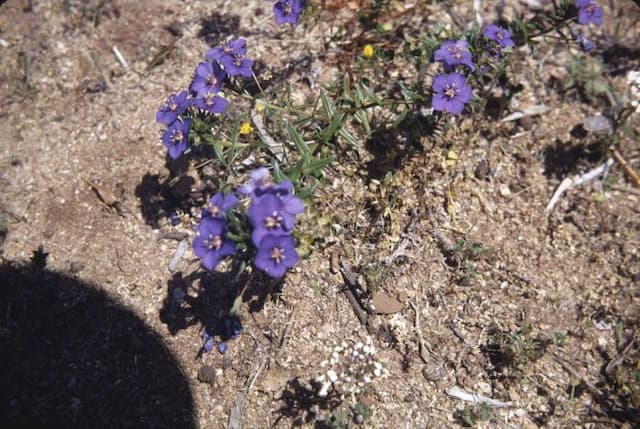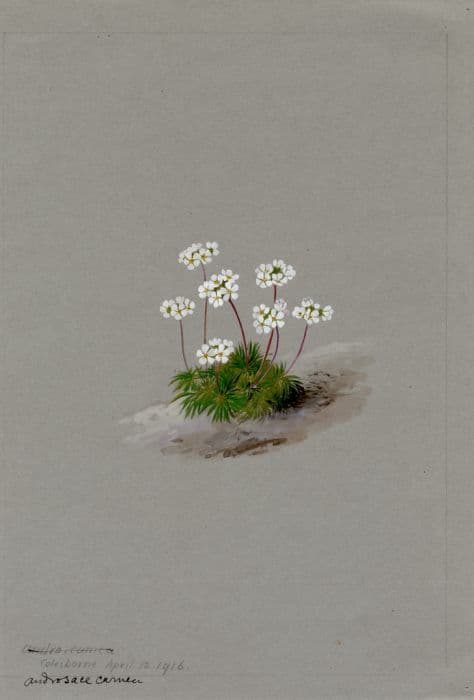Bear's ear auricula Primula auricula 'Baby Blue' (Au)

ABOUT
Primula auricula 'Baby Blue', commonly known as auricula or bear's ear, is a charming perennial plant that is noted for its unique and attractive flowers. The plant produces rosettes of spoon-shaped, fleshy leaves that are typically a soft green color, creating a lush background for the flowers. These leaves sometimes have a slight powdery or farinose surface which gives them a distinctive appearance. The blooms of the auricula 'Baby Blue' are the true highlight, characterized by their bright and eye-catching look. The flowers are a beautiful shade of pastel blue with a brighter or sometimes creamy-yellow center, known as the eye. This combination of shades provides a delightful contrast that makes the flowers stand out in the garden. The blossoms have a rounded shape with a velvety texture, and they are typically arranged in clusters that rise above the foliage on slender stalks, creating a lovely display that can catch the attention of any passerby. The arrangement of the flowers often gives the plant a neat and organized appearance, with each bloom being set off by the greenery below. Throughout its blooming period, the auricula 'Baby Blue' provides gardeners with a continuous splash of color, adding a sense of elegance and tranquility to the setting. While these delicate-looking flowers are robust and quite hardy, they convey a sense of gentleness and old-world charm that is often associated with cottage gardens.
About this plant
 Names
NamesFamily
Primulaceae.
Synonyms
Bear's Ear, Mountain Cowslip, Auricula.
Common names
Primula auricula 'Baby Blue' (Au)
 Toxicity
ToxicityTo humans
Auricula is generally considered non-toxic to humans. However, some people may experience mild irritation or an allergic reaction when handling the plant due to the presence of primin, a compound found in the foliage. If ingested, there might be a possibility of mild gastrointestinal upset, but auricula is not known for severe toxicity in humans.
To pets
Auricula is not widely recognized as being toxic to pets. However, as with humans, the primin compound in the plant can potentially cause mild dermatological reactions if pets come into contact with the foliage. If a pet ingests the auricula, they might experience mild gastrointestinal discomfort, but severe poisoning is unusual. Owners should still exercise caution and keep an eye out for any unusual symptoms if ingestion occurs.
 Characteristics
CharacteristicsLife cycle
Perennials
Foliage type
Evergreen
Color of leaves
Green
Flower color
Blue
Height
6 inches (15 cm)
Spread
6 inches (15 cm)
Plant type
Herb
Hardiness zones
5
Native area
Europe
Benefits
 General Benefits
General Benefits- Aesthetic Appeal: The 'Baby Blue' Auricula adds a splash of color with its striking blue flowers, making it an attractive addition to gardens and container plantings.
- Pollinator Attraction: Auriculas are known to attract bees and butterflies, supporting local ecosystems and aiding in pollination of other plants.
- Easy to Grow: Primula auricula 'Baby Blue' is generally easy to care for and maintain, making it suitable for gardeners of all skill levels.
- Extended Blooming Season: Auriculas have a relatively long flowering period, bringing interest to the garden throughout spring.
- Compact Size: As a small perennial, it's ideal for rockeries, alpine gardens, or small spaces where larger plants would be overwhelming.
- Seasonal Variety: The distinctive foliage and the structure of the Auricula add variety to the garden across seasons.
 Medical Properties
Medical PropertiesThis plant is not used for medical purposes.
 Air-purifying Qualities
Air-purifying QualitiesThis plant is not specifically known for air purifying qualities.
 Other Uses
Other Uses- Floral Arrangements: Auricula 'Baby Blue' can be used in floral arrangements for its distinctive shape and blue-colored flowers, adding a unique touch to bouquets and centerpieces.
- Photography Prop: The plant's vivid blooms make it a beautiful subject for botanical photography, creating visually striking images.
- Craft Projects: Pressed auricula flowers can be used in scrapbooking or other paper crafts, retaining their color and shape well when dried.
- Culinary Garnish: Although not commonly known for culinary uses, the flowers of Auricula 'Baby Blue' can add a colorful garnish to salads and desserts.
- Wedding Decor: Its eye-catching flowers can be integrated into wedding decor themes, particularly for spring weddings.
- Educational Tool: Auricula 'Baby Blue' can be used to teach children or gardening beginners about plant growth and care due to its ease of cultivation.
- Artistic Inspiration: Artists may draw inspiration from the unique color and structure of Auricula 'Baby Blue' for paintings, textile designs, or other art forms.
- Theme Gardens: It can be included in "blue" or pastel-themed gardens to create a visually harmonious landscape design.
- Dye Source: The pigments in auricula petals may be used to naturally dye fabrics or paper a soft blue hue.
- Ice Cubes: Flower petals can be frozen into ice cubes for an elegant and surprising touch in beverages at special events or parties.
Interesting Facts
 Feng Shui
Feng ShuiThe Auricula is not used in Feng Shui practice.
 Zodiac Sign Compitability
Zodiac Sign CompitabilityThe Auricula is not used in astrology practice.
 Plant Symbolism
Plant Symbolism- Rarity and Uniqueness: The Primula auricula, also known as "Auricula," is often sought after by collectors due to its unique and varied colors, which can symbolize the rarity and uniqueness in an individual or relationship.
- Delicacy: With its delicate appearance, the Auricula may represent the delicacy of emotions and the need for gentle care in personal connections.
- Boldness: Despite its delicate look, the Auricula is quite hardy. Its ability to stand out among other flowers can symbolize boldness or a stand-out character in a person.
- Bewitching Beauty: The Auricula, with its striking colors and patterns, is known to captivate and can represent a bewitching beauty, suggesting an alluring and mysterious charm.
- Precision and Attention to Detail: The intricate patterns of the Auricula's petals may signify a love for precision and attention to detail in one's live and work.
 Water
WaterThe Bear's Ear should be watered thoroughly, allowing the soil to become slightly dry between waterings. Typically, this might mean watering with about 1-2 gallons per week, depending on the climate and the plant's environment. Overhead watering should be avoided to prevent leaf and crown diseases. Instead, water directly at the base or use a drip system or watering can. During the growing season in spring and summer, the plant may require more frequent watering, while in the cooler fall and winter months, the watering frequency should be reduced.
 Light
LightBear's Ear thrives in bright, indirect light or partial shade. It benefits from being in a spot that receives morning sunlight but is shielded from the intense light of midday. An east-facing window or a location that receives filtered sunlight is optimal for indoor plants, while in the garden they should be planted in a spot with dappled shade.
 Temperature
TemperatureBear's Ear is best cultivated in temperatures between 50 and 75 degrees Fahrenheit. It can tolerate temperatures as low as 20 degrees Fahrenheit but should be protected from frost. To promote flowering, a cooler period with nighttime temperatures between 40 and 50 degrees Fahrenheit is beneficial.
 Pruning
PruningBear's Ear benefits from pruning to remove dead or fading flowers, which encourages more blooms and prevents seeding. Pruning should be done after the main bloom in late spring or early summer. Remove dead leaves and spent flower stems to maintain plant health and appearance.
 Cleaning
CleaningAs needed
 Soil
SoilThe best soil mix for the Auricula Primrose, commonly known as 'Auricula', should be well-draining with a high content of organic matter, such as a mix of loam, peat, and perlite. The soil pH should ideally be slightly acidic to neutral, ranging from 6.0 to 7.0.
 Repotting
RepottingAuricula Primrose should be repotted every one to two years to refresh the soil and accommodate root growth. Fall is the best time for repotting to avoid disrupting the spring bloom cycle.
 Humidity & Misting
Humidity & MistingAuricula Primrose thrives in moderate humidity levels, ideally between 50% and 60%. They do not need high humidity and should be protected from overly wet conditions which can lead to fungal diseases.
 Suitable locations
Suitable locationsIndoor
Keep Auricula in bright, indirect light, cool temp.
Outdoor
Plant in partial shade, sheltered from wind, moist soil.
Hardiness zone
4-8 USDA
 Life cycle
Life cycleThe Bear's ear 'Baby Blue' begins its life as a seed, typically planted in the late winter or early spring. Upon germination, the seedling stage is marked by the emergence of the first leaves, and the plant establishes itself with a small root system. The vegetative stage follows, during which the plant grows larger leaves and develops a more robust root system. The next significant growth stage is the flowering phase, where Bear's ear 'Baby Blue' produces its characteristic blue blooms, which generally occurs in spring or early summer, depending on the climate. After pollination, the plant sets seed, completing its reproductive cycle. Finally, in the post-blooming period, the plant enters a state of dormancy, particularly in colder climates, where it rests until the next growing season.
 Propogation
PropogationPropogation time
Spring-Early Summer
Propogation: The ideal time to propagate the Primula auricula 'Baby Blue', commonly known as Auricula, is during late winter through to early spring. The most popular method of propagation for this plant is division. This involves carefully separating offsets from the parent plant when they have formed their own roots. Typically, you would dig up the Auricula after it has finished flowering, gently tease apart the clumps ensuring each division has a portion of root attached, and then replant the divisions at the same depth they were previously growing. It's important to water them in well after planting, providing about an inch (2.54 cm) of water to help establish them. This method is favored because it maintains the genetic integrity of the cultivar and allows for the gradual expansion of the garden or collection.









